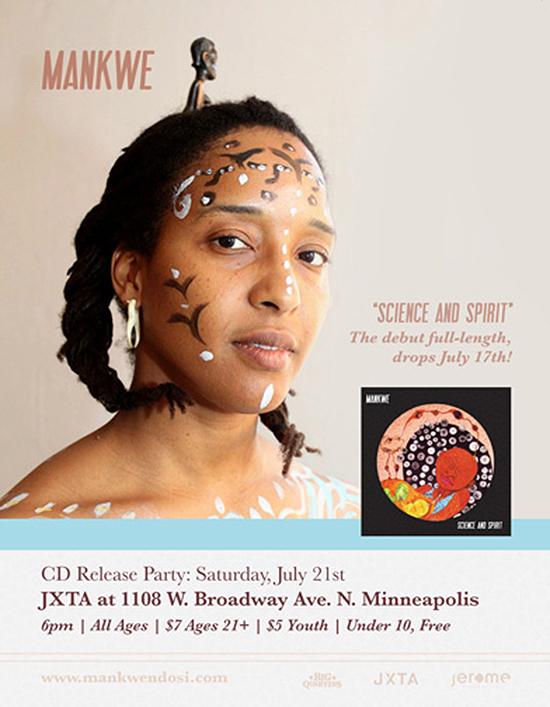Interview by Visual Collaborative
March 2019 5 min read
Mankwe Ndosi’s creative practice spans genres and disciplines, weaving influences from Jazz and African legacies, Hip Hop, Soul, performance art, theater, public art and improvisation. Based in Minneapolis Minnesota, she served as artistic director at the Center for independent artists during Visual Collaborative’s inaugural exhibition in 2007. In this interview she tells us about her diverse background in activism and the arts.
Your name last name Ndosi seems pan-African, can you tell us a little bit about your heritage and how you integrate it into the message of your work?
I am of Tanzanian and African American ancestry, born and based in Minneapolis, Minnesota. My paternal line is Meru from the highlands of Mt. Meru in the Arumeru district of Tanzania. My mother is African American from St. Louis. I have always believed that folks from the continent and from the African Diaspora have a lot to offer each other in our world that is still afflicted by an anti-African bias. So a lot of my walk in the world is focused on helping Black people from around the world to see and value each other better – to recognize our worlds of genius, cultures and healing possibilities among us as we connect to each other and the world.
You served as Artistic Director at the Center for Independent Artists, inside Instituto de Cultura y Educacion where Visual Collaborative held its inaugural event in 2007. What was your experience working with its curator and the featured artists like Miko Simmons?
I remember Ade’s enthusiasm, creativity, and determination! How exciting it was to have a curator interested in supporting Diasporic artists of multiple genres. I remember how exciting it was in Minnesota to have the gallery full of folks from all over the continent and the world! I’m overjoyed that it’s still rolling!
We have to be able to get together and make some radical changes in what we believe is most important – follow indigenous wisdom from around the world to live simply so that we all may simply live.
In recent years you have performed as a vocalist on television and at numerous venues in Chicago. Was that always the vision to expand into different spheres of the arts?
I’m a performer with theater as my first genre, but singing as my root, my home. I love to sing, it heals and moves me and anywhere I can do it within the context of a healthy connection/work relationship, I feel blessed to do so. I’m kind of a voracious artist in that way – I love to sing with all kinds of artists – poets, performance art and theater, dance, visual, other musicians, vocalists, folks on the street and with animals, machines, the elements – bring it on! By the time I led the Center for Independent Artists, I’d already been working with so many different genres of artists. It keeps going and I love it!

The field of humanities is vast and specifically the creative arts; literally, visual or music which plays a vital role in the United States. Would you consider your music social conscious and to what end?
I am one of my father’s activist children. I have always been an activist and so a lot of active racial justice and group healing work. I consider myself a Culture Worker – using my creative practice to nurture connections among people, ancestors, and the earth. We are in a time where it’s critical for us to understand the limitations of capitalism, to make genuine and liberatory connections between people. We have to be able to get together and make some radical changes in what we believe is most important – follow indigenous wisdom from around the world to live simply so that we all may simply live. So I sing to the plants and the sky, the animals and the people, to the Creator, the Orisa and the ancestors, and to heal my own heart and mind.
I am an Ifa practitioner and also listen to mystics and meditators from around the world. I am inspired by children and am deeply moved and healed by the natural world.
In your quiet or noisy moments, how do you get inspired to inspire others? What ultimately motivates you to do the work you do. Are you religious or physiological like many in your field?
I am inspired by my ancestors, by my community, by activists and creators and those who make healing transformation possible all over the world. I am an Ifa practitioner and also listen to mystics and meditators from around the world. I am inspired by children and am deeply moved and healed by the natural world. I am committed to listening and following the lead of the earth and of indigenous people from around the world as the authorities on how we live in right relationship with each other and with the earth.
If you can time-warp back to any era, what time would it be and why?
I would like to feel what it was like to grow up from a girl to a woman within a matriarchal African culture. West or East coast. I’d like to have experienced the genius and wholeness of a pre-colonial matriarchal indigenous culture – with spiritual practice and culture and connection to our homeland intact. To have grown up in a culture where femininity is honored as an everyday, common practice.
What can the community expect for Mankwe Ndosi over the next 5 years?
You can expect some musical adventures released. The development and deepening of liberatory group healing practice or ritual. More music and more love and more liberation and more joy!

Body Painting by Ta’Coumba Aiken,
Design by Elizabeth Brazen
Album art by Chamindika Wanduragala